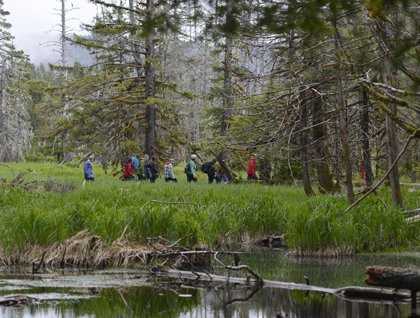Early in the morning we made our way south in Chatham Strait. Chatham is huge, joining with Lynn Canal to make the largest fjord in North America. It is one of the few places in the Inside Passage with enough fetch to develop significant waves. We motored through some chop, enough to cast spray up from the ship’s bow, until we turned into the protected waters of Kelp Bay.
Just after breakfast we took our rubber boats ashore to Pond Island. Here we stepped into temperate rain forest. Moss carpeted the forest floor, soft underfoot, and trees reached out of sight to a gentle grey sky. We met the common trees of the Tongass National Forest – spruce, hemlock, and alder. Beneath these hunkered ferns and huckleberry. We heard songbirds tweedling from the treetops – warblers, kinglets and thrushes. We found meadows of sedge clipped by the dainty mouths of deer and an impressive bear track. Many of us followed a rugged trail over and under fallen logs to a series of beaver dams. Here we found one of early summer’s delights – the calypso orchid. This rare flower is as bright and intricate as any corsage. In twenty years, I have never seen these flowers elsewhere in Alaska – an indication that Southeast Alaskan forest, while homogeneous at first glance, is really full of intricacy and nuance.
We spent the afternoon riding northward easily with the waves. We passed a humpback whale, which lifted its flukes obligingly, but much of the rest of the day was spent in preparation for the rest of our Alaskan experience. We heard naturalists speak about photography, Alaskan history and the biology of humpback whales.
Both in the field and on the ship, today was a fine introduction to the richness of Alaska’s cultural and natural history.









